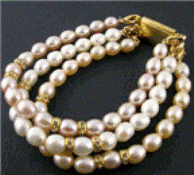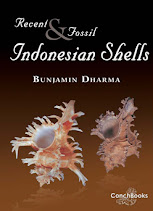Source:
http://news.yahoo.com SHANGHAI (Reuters) - The prices of the lustrous strings of pearls that line display cases in Shanghai jewelry stores are more eye-catching than the glossy gems: some pearl sets cost under 10 yuan ($1.50) even before bargaining.
"All kinds of people come to buy pearls, Chinese and foreigners," said Wang Caijiao, who has been selling pearls in a two-storey shop on Shanghai's bustling
Nanjing Road for seven years.
The massive volume of freshwater pearls on the market have made the gem affordable to the masses.
That might be good news for the migrant laborers and factory workers who can now afford pearls but it is bad news for the pearl industry which frets over the sinking prices of pearls and the damage to the gem's once exclusive image.
Now, local Chinese governments, concerned about environmental damage to lakes and reservoirs from pearl cultivation, are beginning to rein in production.
And what's healthy for the environment may end up being healthy for the industry as well.
"The pearl industry has not been doing well in the past two years because the output is too high," said Li Jiale, a professor at Shanghai Ocean University.
"The industry needs to reduce quantity and improve quality."
Pearl farms now earn less than 2,000 yuan per kilogram of pearls, down from a peak above 20,000 yuan more than a decade ago, Li said.
In 2007, China produced 1,600 tonnes of pearls, over 95 percent of the world's total output, the Gems and Jewellery Trade Association of China said on its website ( http://www.jewellery.org.cn ).
Most are rough-edged, elongated orbs like those threaded into necklaces in Wang's shop. Perfectly shaped salt water pearls that are formed by nature can fetch millions of dollars.
POLLUTING PEARL FARMERS
The massive quantities of pearls produced by China's pearl industry carry a hefty environmental cost.
Lake waters where the pearls are cultivated are greenish, cloudy and often foul-smelling from a mixture of pollution and fertilizers dumped into the water to help the mussels produce pearls faster.
"The disorderly growth of freshwater pearl cultivation in some regions, resulting in the dumping of large quantities of fertilizer into lakes and reservoirs, has seriously damaged those water bodies," said a document on the website of the agriculture department of central China's Hubei Province ( http://www.hbagri.gov.cn ).
Hubei, one of China's biggest pearl producers, last year banned pearl cultivation in lakes and reservoirs, and restricted pearl-producing mussels to ponds.
Several cities and regions in southern China have also banned or restricted pearl cultivation in recent years.
But experts said mussels, used to produce the gems in freshwater, while oysters produce pearls in saltwater, should not pollute the environment if they are raised properly.
"Mussels eat plankton in the water and can therefore actually purify it," said Pan Jianlin, secretary-general of the Jiangsu Province Pearl Industry Association.
"But some farmers are not raising pearls properly. They use fertilizer to feed the plankton," he said.
Overly dense mussel populations compound the pollution, experts said.
"If mussels are raised in an enclosed body of water, it can easily lead to eutriphication," or a rise in chemical nutrients that causes a severe deterioration of water quality, said Cheng Wen, a professor at Xi'an University of Science and Technology.
LESS IS MORE
Environmental damage from pearl culture is minor compared with industrial emissions, heavy fertilizer runoff and untreated sewage that have fouled many Chinese rivers and lakes over three decades of break-neck economic growth.
Local governments are now under pressure to attack all sources of pollution.
Hit by the restrictions, as well as rising costs and falling prices, China's pearl output is expected to fall to 1,400 tonnes in 2008 and 1,000 tonnes by 2010, down more than one-third from last year, the Gems and Jewellery Trade Association of China said.
Lower production might not hit profits. Experience in other pearl-producing regions has shown that producing smaller quantities of higher quality gems can actually bring better returns for the industry as a whole.
"It's important that pearl farmers know that producing 100 kilograms of pearls is not more profitable than producing 20 kilograms," said Qiu Zhili, associate professor of earth sciences at Sun Yat-sen University in Guangdong province.
In French Polynesia, where Tahitian pearls are cultivated, the local industry association compiles output plans and strictly regulates market access. Pearls that do not meet gem grade standards cannot be sold as jewelry, Qiu said.
The quality of China's freshwater pearls is starting to improve and if cultivated properly, with lower densities of mussels in ponds and longer cultivation times, experts said they could look more like the smooth, perfectly round saltwater pearls from Japan and the South Pacific that command far higher prices.
But that is not likely to happen either quickly or easily.
"I'd like to see output fall to 100 tonnes. Then our pearls would be priced at the same levels as Tahitian pearls and South Sea pearls. That would be great," said Du Kunlin, secretary general of Zhejiang Province Pearl Industry Association.
But he added: "Tens of thousands of pearl farmers live off of them. You can't just let only 10,000 of them survive."
($1=6.839 Yuan)
(Editing by Edmund Klamann and Megan Goldin)
 Hyderabad may still be the 'City of Pearls', but it is increasingly pearls from China that are dominating the city's trade in pearls.
Hyderabad may still be the 'City of Pearls', but it is increasingly pearls from China that are dominating the city's trade in pearls. 


